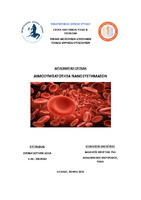| dc.contributor.advisor | Μπίρτσας, Βασίλειος | |
| dc.contributor.author | Λόλα, Ειρήνη Σωτηρία | |
| dc.date.accessioned | 2024-10-22T06:56:45Z | |
| dc.date.available | 2024-10-22T06:56:45Z | |
| dc.date.issued | 2024-10-08 | |
| dc.identifier.uri | https://polynoe.lib.uniwa.gr/xmlui/handle/11400/7842 | |
| dc.identifier.uri | http://dx.doi.org/10.26265/polynoe-7674 | |
| dc.description.abstract | Τα νανοσωματίδια χρησιμοποιούνται για την πρόληψη, διάγνωση και θεραπεία
ασθενειών, χάρη στην ικανότητα έγκλησης ουσιών, όπως φαρμακευτικών ουσιών.
Ωστόσο, κάθε νέο νανοσωματίδιο που κατασκευάζεται πρέπει να ερευνάται ως προς
την βιοσυμβατότητα του και τις πιθανές τοξικές επιδράσεις στον οργανισμό. Η
συμβατότητα τους με το αίμα (αιμοσυμβατότητα) είναι μεγάλης σημασίας, καθώς το
αίμα είναι ο πρώτος ιστός με τον οποίο έρχονται σε επαφή κατά την είσοδό τους στον
οργανισμό.
Τα πολυμερικά νανοσωματίδια, δηλαδή νανοσωματίδια κατασκευασμένα από
φυσικά ή συνθετικά πολυμερικά νανοϋλικά, εμφανίζουν μεγάλα ποσοστά
συμβατότητας. Συγκεκριμένα τα νανοσωματίδια αλγινικού οξέος εμπίπτουν στην
κατηγορία φυσικών πολυμερικών. Είναι γνωστά για την πολύ μικρή τοξικότητά τους
και για την ικανότητα τους να εγκλείουν ουσίες και να τις απελευθερώνουν
ελεγχόμενα. Τέτοιες ουσίες είναι η χρυσίνη, η οποία είναι φυσική φλαβόνη και
διαθέτει πλήθος φαρμακευτικών ιδιοτήτων, όπως αντικαρκινικές ιδιότητες.
Σκοπός της παρούσας πτυχιακής εργασίας είναι η μελέτη της συμβατότητας του
νανοσυστήματος πολυμερικών νανοσωματιδίων αλγινικού οξέος με εγκλωβισμένη
χρυσίνη με τα ερυθρά αιμοσφαίρια. Η αιμοσυμβατότητα των νανοσωματιδίων
αξιολογήθηκε ως προς τα ποσοστά αιμόλυσης (λύση των ερυθροκυττάρων και
απελευθέρωση της αιμοσφαιρίνης στο πλάσμα) και την μορφολογία των ερυθρών,
μετά από επωάσεις του αίματος υγειών ανθρώπων με το παραπάνω νανοσύστημα.
Συγκεκριμένα, έγινε αιματολογική ανάλυση και αξιολόγηση των δοτών, δοκιμασίες
ωσμωτικής αντίστασης και κρυοαιμόλυσης, καθώς και χρώση Μay – Grumwald -
Giemsa και μικροσκόπηση επιχρισμάτων αίματος πριν και μετά από τετράωρη
επώαση με τα νανοσυστήματα.
Από τα αποτελέσματα που προέκυψαν, συμπεραίνεται ότι το παραπάνω
νανοσύστημα και τα επιμέρους τμήματα του δεν προκαλούν αιμόλυση, παρά μόνο
κάποιες μικρές αυξήσεις του MCV και μικρές μειώσεις των MCH και MCHC εντός των
φυσιολογικών ορίων. Ακόμη, παρατηρήθηκε ότι κατά την παρουσία του
νανοσυστήματος και κυρίως του αλγινικού οξέος, τα ερυθοκύτταρα χάνουν την
φυσιολογική μορφή τους και μετατρέπονται σε ακανθοκύτταρα σε μικρό ποσοστό,
χωρίς αυτό να είναι ικανό να προκαλέσει ποικιλοκυττάρωση. Προκύπτει κατά αυτόν
τον τρόπο ότι το νανοσύστημα είναι αιμοσυμβατό με τα ερυθρά αιμοσφαίρια. | el |
| dc.format.extent | 77 | el |
| dc.language.iso | el | el |
| dc.publisher | Πανεπιστήμιο Δυτικής Αττικής | el |
| dc.rights | Αναφορά Δημιουργού - Μη Εμπορική Χρήση - Παρόμοια Διανομή 4.0 Διεθνές | * |
| dc.rights | Attribution-NonCommercial-NoDerivatives 4.0 Διεθνές | * |
| dc.rights | Attribution-NonCommercial-NoDerivatives 4.0 Διεθνές | * |
| dc.rights | Attribution-NonCommercial-NoDerivatives 4.0 Διεθνές | * |
| dc.rights | Attribution-NonCommercial-NoDerivatives 4.0 Διεθνές | * |
| dc.rights.uri | http://creativecommons.org/licenses/by-nc-nd/4.0/ | * |
| dc.subject | Ερυθροκύτταρο | el |
| dc.subject | Νανοσωματίδια | el |
| dc.subject | Χρυσίνη | el |
| dc.subject | Αιμόλυση | el |
| dc.subject | Αλγινικό οξύ | el |
| dc.title | Αιμοσυμβατότητα νανοσυστημάτων | el |
| dc.title.alternative | Nanosystems hemocompatibility | el |
| dc.type | Πτυχιακή εργασία | el |
| dc.contributor.committee | Μπίρτσας, Βασίλειος | |
| dc.contributor.committee | Dryllis, Georgios | |
| dc.contributor.committee | Kriebardis, Anastasios | |
| dc.contributor.faculty | Σχολή Επιστημών Υγείας & Πρόνοιας | el |
| dc.contributor.department | Τμήμα Βιοϊατρικών Επιστημών | el |
| dc.description.abstracttranslated | Nanoparticles are used for the prevention, diagnosis and treatment of diseases due to
their ability to enclose substances such as pharmaceuticals. However, every new
nanoparticle that is manufactured must be investigated for its biocompatibility and
potential toxic effects on the body. The compatibility of nanoparticles with blood
(hemocompatibility) is of great importance, as blood is the first tissue with which they
come into contact upon entering the body.
Polymeric nanoparticles, i.e. nanoparticles made of natural or synthetic polymeric
nanomaterials, show high rates of compatibility. Specifically, alginic acid nanoparticles
fall into the category of natural polymers. They are known for their very low toxicity
and their ability to encapsulate substances and release them in a controlled manner.
Such substances are chrysin, which is a natural flavone and has a number of medicinal
properties, including anti-cancer properties.
The purpose of this thesis is to study the compatibility of the nanosystem of alginic
acid polymeric nanoparticles with encapsulated chrysin with red blood cells. The
hemocompatibility of the nanoparticles was evaluated in terms of hemolysis rates
(lysis of erythrocytes and release of hemoglobin into the plasma) and erythrocyte
morphology, after incubating the blood of healthy people with the nanosystem. In
particular, hematological analysis and evaluation of the donors, osmotic resistance and
cryohemolysis tests, as well as May - Grumwald - Giemsa staining and microscopy of
blood smears before and after a four-hour incubation with the nanosystem were
performed.
From the obtained results, it is concluded that the nanosystem and its individual parts
do not cause hemolysis, except for some small increases in MCV and small decreases
in MCH and MCHC within normal limits. Furthermore, it was observed that in the
presence of the nanosystem, especially alginic acid, erythrocytes lose their normal
shape and turn into acanthocytes to a small extent, without causing poikilocytosis.
Thus, it appears that the nanosystem is hemocompatible with red blood cells. | el |


